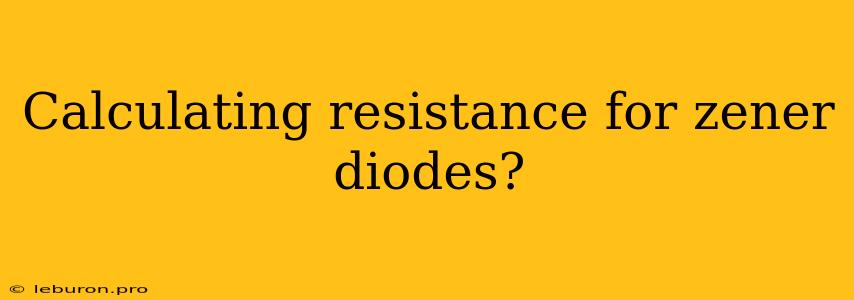Zener diodes, known for their ability to maintain a constant voltage across their terminals despite changes in current, are essential components in various electronic circuits. Determining the appropriate resistance for a Zener diode is crucial for proper circuit operation, ensuring the diode functions within its safe operating range. This article will delve into the process of calculating resistance for Zener diodes, providing a comprehensive understanding of the factors involved and offering practical guidelines for accurate calculation.
Understanding Zener Diode Operation
A Zener diode is a specially designed PN junction diode that exhibits a breakdown voltage known as the Zener voltage (Vz). When the reverse voltage across the diode exceeds Vz, it enters the breakdown region, where it conducts current while maintaining a relatively stable voltage. This characteristic makes Zener diodes ideal for voltage regulation, limiting voltage fluctuations and providing a reference voltage in electronic circuits.
Zener Diode Characteristics
- Zener Voltage (Vz): The voltage at which the Zener diode enters the breakdown region. This voltage is a key parameter, determining the regulated output voltage.
- Zener Current (Iz): The current flowing through the diode when it is operating in the breakdown region.
- Zener Power Dissipation (Pz): The maximum power the diode can handle without being damaged. This is typically calculated as Pz = Vz * Iz.
- Zener Impedance (Zz): The dynamic resistance of the diode in the breakdown region, indicating how much the voltage changes with changes in current.
Calculating Resistance for Zener Diodes
The primary objective of calculating resistance for a Zener diode is to ensure its stable operation and prevent damage. This involves ensuring the diode operates within its rated power dissipation and current limits. The following steps outline the process for determining the appropriate resistance:
1. Determine the desired regulated output voltage (Vo): This voltage should be equal to or slightly lower than the Zener voltage (Vz) to ensure the diode operates in its breakdown region.
2. Choose a Zener diode with the appropriate Zener voltage (Vz) and power rating: The Zener voltage should be chosen according to the desired output voltage, and the power rating should exceed the expected power dissipation.
3. Calculate the current through the Zener diode (Iz): This current is the current that flows through the diode when it is operating in the breakdown region. It can be calculated using the equation:
Iz = (Vs - Vz) / R
where:
- Vs: Source voltage
- Vz: Zener voltage
- R: Resistance
4. Determine the maximum current through the resistor (Ir): This current is the sum of the Zener current (Iz) and the load current (Il):
Ir = Iz + Il
5. Calculate the required resistance value (R): Use Ohm's law to calculate the resistance:
R = (Vs - Vz) / Ir
6. Select a standard resistor value that is closest to the calculated value: Choose a standard resistor value that is slightly higher than the calculated value to ensure the diode operates within its safe operating range.
Example Calculation
Consider a circuit where a 12V source (Vs) is to be regulated to 5V using a Zener diode with a Zener voltage (Vz) of 5.1V. The load current (Il) is 100mA, and the Zener diode has a power rating of 1W.
- Determine the regulated output voltage (Vo): Vo = 5V.
- Choose a Zener diode: We have chosen a Zener diode with Vz = 5.1V and a power rating of 1W.
- Calculate the Zener current (Iz): The Zener current can be calculated using the equation:
Iz = (Vs - Vz) / R
Iz = (12V - 5.1V) / R
Iz = 6.9V / R
- Determine the maximum current through the resistor (Ir):
Ir = Iz + Il
Ir = 6.9V / R + 100mA
- Calculate the required resistance value (R):
R = (Vs - Vz) / Ir
R = (12V - 5.1V) / (6.9V / R + 100mA)
R = 6.9V / (6.9V / R + 0.1A)
R = 69 ohms
- Select a standard resistor value: Choose a standard resistor value of 75 ohms, slightly higher than the calculated value of 69 ohms.
Considerations for Resistance Selection
- Power Dissipation: The resistor must be rated to handle the power dissipated across it. The power dissipated in the resistor (Pr) can be calculated using the formula:
Pr = Ir^2 * R
-
Voltage Drop: The resistance should be chosen to minimize the voltage drop across it, ensuring the regulated output voltage (Vo) is close to the Zener voltage (Vz).
-
Zener Diode Characteristics: The Zener impedance (Zz) and temperature coefficient can also influence the accuracy of the regulated voltage.
-
Circuit Application: The specific requirements of the circuit, such as load variations or noise sensitivity, may necessitate adjustments to the resistance value.
Conclusion
Calculating resistance for a Zener diode is a critical step in designing and implementing voltage regulation circuits. By carefully considering the Zener voltage, current ratings, and power dissipation, you can ensure the diode operates within its specifications, providing a stable and reliable regulated output voltage. Understanding the key factors discussed in this article empowers you to accurately determine resistance values, optimizing Zener diode performance in various applications.
